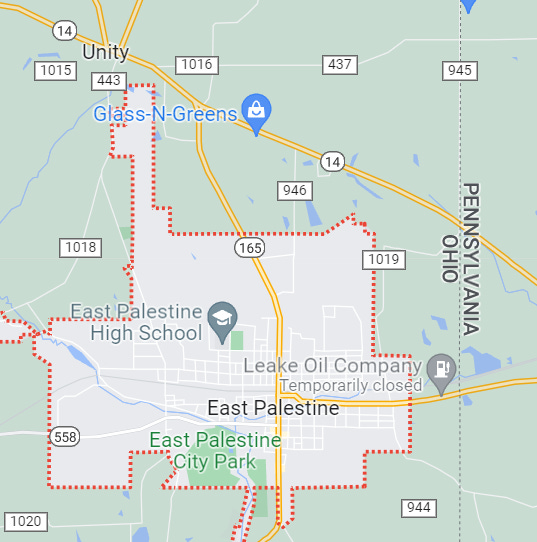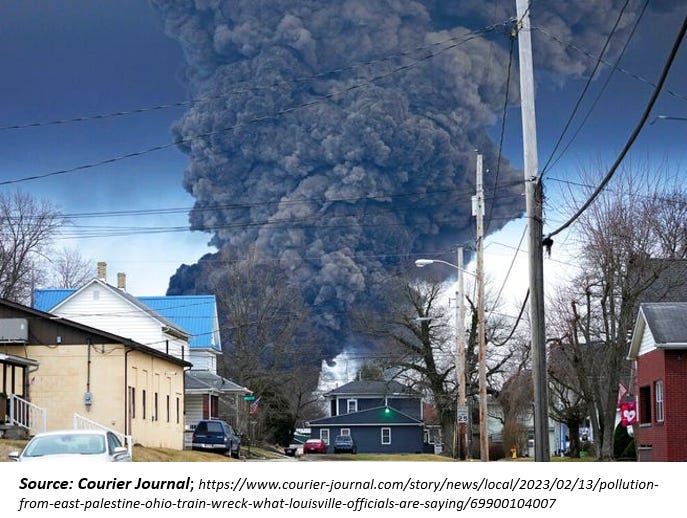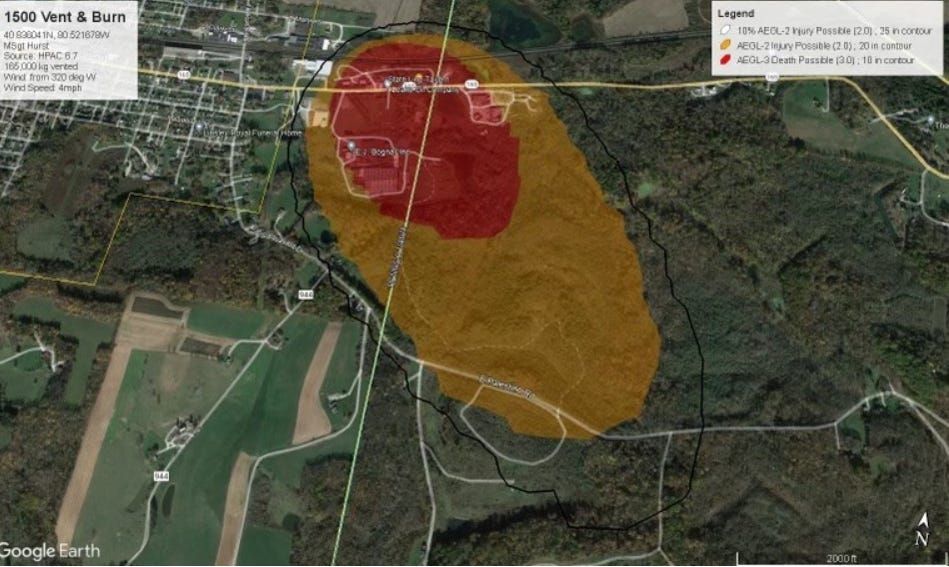Norfolk Southern Train Wreck Rains Toxins over Ohio and Pennsylvania, USA
The company made an initial offering of $25k to the town to “help” clean up
On February 3, 2023, around 50 Norfolk Southern train cars derailed in East Palestine, Ohio. Reports stated that as many as 10 of the cars contained toxic chemicals. Chemicals identified by the Environmental Protection Agency (EPA) include Vinyl Chloride, Ethylene Glycol Monobutyl, Ether, Ethylhexyl Acrylate, and Isobutylene. As a precaution against explosions, authorities burned off one of those chemicals, vinyl chloride, from inside five cars. Emergency operations often involve burning off hazardous gases to control their inevitable release. Indeed, in the fire service I myself have commanded such an incident type, burning off volatile gases from a tank leak to reduce the chance of an explosion through a controlled depletion. In a train derailment, the chances of effectively containing an uncontrolled leak or catastrophic explosion are small, so burning off the material may have been the best—or only—option. In an incident this large, however, an explosion is only the imminent problem. The longer-lasting problem will be the environmental damage caused by the response.
Vinyl chloride is used to make polyvinyl chloride hard plastic resin in plastic products, such as credit cards, PVC pipes, and some car parts. Its production has increased by about 3% annually since the 1990s. Burning it releases phosgene and hydrogen chloride into the air. Phosgene is a poisonous gas at room temperature, and was once used as a suffocating agent in World War I. Even low exposure can lead to long-term effects such as emphysema or chronic bronchitis. Hydrogen Chloride is corrosive when exposed to air, and concentrations above 5 ppm can cause irritation while higher doses may cause asphyxiation. NIOSH (the National Institute for Occupational Safety & Health) considers concentrations of 50 ppm or above dangerous to life or health.
At the onset of the incident, the government ordered evacuations in areas both in Ohio and Pennsylvania. While the burn-off was happening in East Palestine, EPA officials continuously monitored air quality in several neighboring communities. This involved taking measurements in the outside air and inside of enclosures, as both of the byproduct gases are heavier than air and have the potential to settle in low-lying or confined spaces. Five days after the incident, nearby residents were allowed to return to their homes. Local residents expressed fears about this, despite being told by officials at the EPA that it was safe to do so. These same residents reported observing dead fish in local bodies of water and sick animals (though so far, no confirmation has been made of injury or death to animals other than fish), while some also complained of headaches and feeling sick. Ohio Department of Natural Resources officials told a Cleveland-based news agency that so far, 3,500 fish across roughly 7.5 miles of streams in the area have been found dead. Residents also remained skeptical because the controlled burn had launched huge plumes of smoke into the air, and many people found their homes and possessions covered in residual material of unknown danger. Juliane Beier, a researcher focused on vinyl chloride exposure at the University of Pittsburgh, told The Allegheny Front that while vinyl chloride dissipates in air, it can also contaminate water. The material’s effects on human health, she added, have been “understudied.” Peng Yingdeng from China’s Central Government Supervision Center for Environmental Protection and Emergency Management said that the gases released from burning vinyl chloride also create acid rain which negatively affects crop yields and can remain in soil for decades.
The National Institute of Health lists a rare form of liver cancer (hepatic angiosarcoma), as well as primary liver cancer (hepatocellular carcinoma), brain and lung cancers, lymphoma, and leukemia as potential risks of exposure to vinyl chloride. While the substance generally does not build up in plants or animals people eat, it can leak into and contaminate groundwater. In addition to exposure by drinking it, water contaminated with vinyl chloride can release the substance through vapor created by showering or cooking, leading to inhalation. According to the Wisconsin Department of Health and Human Services, levels of inhalation above 0.62 ppbv (parts per billion by volume) may become dangerous. Water contaminated at 0.2 ppbv or above is considered potentially harmful for drinking.
The Association of American Railroads reports the train accident rate in the United States as down by 31% since 2000. Nonetheless, there were 1,573 rail-related accidents in 2022 alone (this number reflects all types of accidents, not specifically derailments). The total amount of hazardous materials shipped by rail in 2017 (the most recent official figure I could find) was 90.4 million tons. Undoubtedly, that number increases year-to-year, particularly as plastics production is exploding due to its use in the fossil fuel industry. Many of the raw materials used to produce plastic are hazardous, including vinyl chloride. At the same time as the production and transport of hazardous materials grows, rail organizations continue to lobby the federal government to reduce hazard classifications and regulations. The accident train in Ohio is one such example of a dangerous cargo that was exempted from “high-hazard” classification resultant from this lobbying. Not only did the government exempt many hazardous chemicals from heightened classification, but in 2017 the US Department of Transportation also rolled back regulations on enhanced brake systems used by trains hauling certain “hazardous flammable commodities.” According to the Lever, the accident train in Ohio was not equipped with enhanced braking systems. The braking systems on trains without enhanced braking have been described as “Civil War era” technology. Security footage of the incident strongly suggests that a mechanical issue in the under carriage of at least one car may have caused the incident. The footage was taken 20 miles before the incident. Railcars are equipped with systems to alert operators that a problem exists, but here it is unclear if an alert triggered at all, and if it did what the operators did in response.
Incidents of hazardous material release as a result of rail accidents present a significant threat to life, health and property. Trains carry millions of tons of toxic cargo through communities across the United States every year. Despite these facts, the railroad lobby persists in arguing against patently obvious measures to ensure the safety of the industry. In the Ohio incident, the issues were potentially the archaic brake systems and the exemption of the “high-hazard” classification of the cargo. The NTSB has clapped back at this assertion, stating that the enhanced break rule would not have applied here because it only applied to High Hazard Flammable Trains, which under the current rule this one was not. It is open to debate whether the rollback of that rule, though, would have in fact made a difference. Regardless, time will tell whether those issues or negligence also played a role. What’s remarkable about the Ohio case is that the health effects of at least one chemical, vinyl chloride, is “understudied” in the words of a scientist who studies it! It cannot be sound safety or environmental policy to treat the transport of such materials so casually with exemptions in classification and braking systems.
Already, four class action lawsuits for negligence have been filed against Norfolk Southern Rail. Unfortunately, even if successful, these cases are not going to magically fix the environmental issues this crash has created. People in East Palestine and neighboring communities are likely going to face lingering consequences for a long time to come. These lawsuits, though, may partly be in response to a public offer by Norfolk Southern to “donate” toward the cleanup in East Palestine. The company—valued at $55 billion—offered the community $25,000. Twenty. Five. Thousand. The CEO of Norfolk Southern, James A. Squires, made $13,261,278 in 2021, with $4.565 million of that in cash compensation. Calling a contribution of money, however pitiful, toward the cleanup of a disaster you *allegedly* created a “donation” is the height of hubris.
Ohio’s disaster is one among far too many where safety and environmental concerns take a backseat to money and influence. Take, for example, US Congressional Representative Bill Johnson. East Palestine is within his constituency. The Marietta Times opened an article about Johnson arriving at the scene having “put on a hard hat and orange vest to tour the site,” and noted that Johnson is “not afraid to take congressional action if there’s something that can prevent something like this from happening again.” Johnson has been the representative for Ohio’s 6th Congressional District since 2011. He sponsored the Community Fire Safety Act of 2013 (H.R. 3588), which would prevent the EPA from enforcing prohibitions against the use of lead pipes, solder and flux in newly manufactured fire hydrants. He also sponsored H.R.2824, which effectively sought to sideline state regulations against “excess spoil, coal mine waste, and buffers for perennial and intermittent streams.” Relatedly, Johnson voted on House Resolution 38 (115th), that disapproved a rule submitted by the Department of Interior establishing a buffer of 100 feet between streams and mining operations, and imposed stricter standards on mining companies to restore mined land to near its “pre-mining conditions.” Instead, he voted in support of a bill allowing states to set aside funds received under the Infrastructure Investment and Jobs Act to help clean up already abandoned mines… something for which the mining companies seemingly should have been responsible. Also of note, Johnson’s campaign has received thousands of dollars from fossil fuel companies and cargo transport companies among others. His attestations about being unafraid to “take action” against this sort of problem ring rather hollow.
The continued degradation of the environment remains a growing problem of enormous consequences. The inherent complexity in issues such as global warming, ice sheet melting, changing weather patterns, and so forth, leave room for agenda-driven opponents to foment skepticism where there should be little or none. Messaging for global issues certainly needs to improve. But a train derailment that spews plumes of toxic chemicals across two states requires little scientific background to understand the potential implications. Residents are justifiably upset, both with the incident and with the demeaning response by the company who is likely at fault. But Americans living outside of the disaster zone seem far more apathetic (or simply unaware of the severity of the incident). Globally, the situation is different. Social media commentators from around the world expressed sarcasm and even contempt toward this apparent apathy. One mockingly wrote, “Will [the derailment] affect my salary? Will it affect my mortgage?” Another simply stated “Cancer of the Earth, America” on a post about the deaths of animals in this incident. Still another noted, “American infrastructure decaying from the inside out.... While they spend billions trying to control Russia...” Stories appearing on non-US based social media and search indexes reached nearly 50 million views within about 10 days of the incident. On US based social media, including giants like Facebook, views appeared to be substantially less.
Notwithstanding the abundance of withering criticisms from global commentators, it is true that the strength of society’s ire should turn toward those with the power to take measures that would dramatically reduce the numbers and severity of these incidents. Conveying to voters the obvious dangers of deregulating industries involved in the production and transport of extremely dangerous materials should be a non-starter. Images of politicians donning hard hats or rubber boots should not dominate the story when their voting record supports the very deregulation that created the circumstances for these disasters to happen in the first place. Yet, here we are.
update later in the day on 2/15/23 - The EPA has since reported that runoff from the incident had been “observed and detected in samples" from Sulphur Run, Leslie Run, Bull Creek, North Fork Little Beaver Creek, Little Beaver Creek and the Ohio River. It further noted that contaminated soil and liquids were "observed and potentially covered and/or filled." The apparent reason for doing so was to facilitate reconstruction of the rail line. More residents are reporting sick or dead animals, including fish, chickens and foxes. Officials have still not been able to confirm deaths of any non-aquatic animals related to the incident, however they are testing a six-week old calf that died February 11. Nevertheless, at least one federal lawsuit filed in the last day is making the claim that animals have been found dead as far as 20 miles away from the scene. Some who have returned to the area since the EPA gave the “all clear” are complaining of headaches and other ailments along with a strong smell of chlorine in the air. Ohio Health Department Director Bruce Vanderhoff’s response to those complaints was that lingering odors and headaches can happen in “safe” air.
Another negligence lawsuit has been filed against Norfolk Southern, marking at as number 5 (or possibly 6). In addition, Governor DeWine complained that the train was allowed to carry the various hazardous materials with “non-hazardous” labels, an apparent result of the rollback of regulations in 2017 discussed above.
The environmental implications of this disaster remain to be seen. Perhaps the one good to come from this will be reinstatement of effective measures to reduce the chance of such an event recurring, or perhaps even stronger regulations to effectively prevent it.
update 2/17/2023 - Let’s be clear, the potential environmental implications for residents of East Palestine and immediate surrounding areas remains to be seen and certainly are not acceptable. However, reports have been circulating on social media of contaminants traveling across New England. Officials in Rhode Island, for one, have reported no sign of contaminants. Connecticut officials have reported the same. Officials in Erie County, New York stated that “East Palestine’s watershed flows southwest toward the Mississippi River and is geographically isolated from Lake Erie’s watershed, making it impossible for chemical residuals from the derailment to enter our area’s water sources.” The New York State Department of Environmental Conservation has detected no “human health impacts” in the air so far. Low levels of butyl acrylate have been detected in the Ohio River, but Patrick Ray, assistant professor of environmental engineering at the University of Cincinnati, notes that they are not nearly significant enough to pose a risk to people.
In the immediate vicinity of the event, municipal water has been cleared to drink, though officials suggest having private wells tested as they are often closer to the surface and thus more prone to contamination. Furthermore, the EPA released this map depicting the danger level of the air during the burn-off. The area in red was considered “deadly” while the area in orange posed a possibility of lung damage if inhaled. The air has since been deemed safe enough to warrant the return of local residents.
No evidence supports claims of danger to residents living far from the incident. Misinformation has spread so pervasively in recent days that the NTSB has issued a plea for people to stop. This is definitely an environmental disaster, and an avoidable one at that. The push for deregulation of industry and rollback of environmental standards are a real problem. Filling the internet with claims from random social media posts that are either blatantly false or misleading only adds to the general idiocy of political discourse over very serious and potentially dangerous problems. Nothing gets accomplished that way.
update 2/19/23 - 6:10am - To date, 8 lawsuits have been filed against Norfolk Southern seeking more than $5 million in damages. One lawsuit alleges that more than 1.1 million pounds of vinyl chloride entered the air. Most of the lawsuits seek compensation for loss of income, or damages for exposure to cancer-causing chemicals. Others are seeking lost revenue for local businesses as well as punitive damages.
Norfolk Southern endured a lot of criticism when it decided to skip a town hall where residents would inevitably air their grievances about the event. The company claimed it was concerned about physical risks to their employees who might attend, but East Palestine Police stated there was no evidence of any such risk. When asked for proof of their threat claims, a spokesperson emailed that they were “unable to comment.”
In response (though not explicitly to the lawsuits), Norfolk Southern announced that it is “Distributing over $1.7 million in direct financial assistance to more than 1,100 families and a number of businesses to cover costs related to the evacuation.” It also stated it is establishing a $1 million fund to provide donations to the community. The company is reimbursing the East Palestine Fire Department $220,000 to replace their Self-Contained Breathing Apparatus (SCBA) packs that were contaminated in the response. And is providing residents more than 100 air purifiers for their homes.
correction - Above, I mentioned Norfolk Southern’s CEO naming him James A. Squires. The CEO at the time of the incident is Alan Shaw, who acquired the title on May 1, 2022. My point above was to juxtapose the ridiculous comparison of the CEO’s salary to the company’s initial offer of $25,000. The comparison stands. Shaw makes more than $4.5 million per year and owns more than 20 properties in Georgia and Virginia. It also turns out that Shaw was involved in the lobbying that led the Trump administration to rollback the rule on electric brakes.
Moreover, as safety regulations have been rolling back since 2017, train accidents have trended upwards through the end of 2021. In the same time period, Norfolk Southern reduced its workforce by 40 percent, despite spending $196 billion dollars in stock buybacks and dividends. Stock buybacks are when a company buys up its own shares. It is effectively a legal pump-and-dump scam, wherein the company reduces the supply of available stock and thus artificially raises the price. It also spent at least $1.33 million in campaign contributions in 2022 as well as $1.8 million in lobbying.
Find more about me on Instagram, Facebook, Twitter, or Mastodon.






